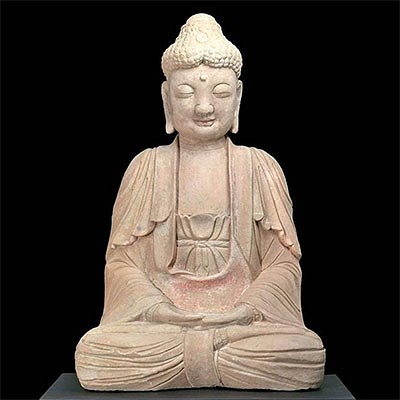11th C. Khmer Stone Buddha on Naga Throne
Lot 85a
About Seller
Artemis Fine Arts
686 S Taylor Ave, Ste 106
Louisville, CO 80027
United States
Selling antiquities, ancient and ethnographic art online since 1993, Artemis Gallery specializes in Classical Antiquities (Egyptian, Greek, Roman, Near Eastern), Asian, Pre-Columbian, African / Tribal / Oceanographic art. Our extensive inventory includes pottery, stone, metal, wood, glass and textil...Read more
Categories
Estimate:
$20,000 - $30,000
Absentee vs Live bid
Two ways to bid:
- Leave a max absentee bid and the platform will bid on your behalf up to your maximum bid during the live auction.
- Bid live during the auction and your bids will be submitted real-time to the auctioneer.
Bid Increments
| Price | Bid Increment |
|---|---|
| $0 | $25 |
| $300 | $50 |
| $1,000 | $100 |
| $2,000 | $250 |
| $5,000 | $500 |
| $10,000 | $1,000 |
| $20,000 | $2,500 |
| $50,000 | $5,000 |
| $100,000 | $10,000 |
| $200,000 | $20,000 |
About Auction
By Artemis Fine Arts
Feb 18, 2021
Set Reminder
2021-02-18 10:00:00
2021-02-18 10:00:00
America/New_York
Bidsquare
Bidsquare : Exceptional Antiquities, Asian, Ethnographic
https://www.bidsquare.com/auctions/artemis-gallery/exceptional-antiquities-asian-ethnographic-6373
Museum-worthy examples of Egyptian, Greek, Roman, Etruscan, Near Eastern, Far East / Asian, Pre-Columbian, African / Tribal, Oceanic, Native American, Spanish Colonial, Russian, Fossils, Ancient Jewelry, Fine Art, so much more! Artemis Fine Arts info@artemisfinearts.com
Museum-worthy examples of Egyptian, Greek, Roman, Etruscan, Near Eastern, Far East / Asian, Pre-Columbian, African / Tribal, Oceanic, Native American, Spanish Colonial, Russian, Fossils, Ancient Jewelry, Fine Art, so much more! Artemis Fine Arts info@artemisfinearts.com
- Lot Description
Southeast Asia, Cambodia, Khmer Empire (Angkor culture), ca. 11th to 13th century CE. A monumental, finely carved stone Buddha, seated on a three-tiered serpentine throne, with the flaring, hooded head of a giant Naga, the serpent king Muchilinda, rising behind him protectively. The Buddha's hands are posed in the Dhyana Mudra. This is a gesture of meditation, with the hands placed in the lap, right hand on left, with fingers full stretched out and palms facing upwards. The Buddha's face is serene, with a naturalistic and warm expression. He wears a magnificent crown that was meticulously incised with intricate beaded and stylized geometric motifs, topped by a similarly elaborately detailed ushnisha, symbolizing his enlightenment. The serpent is well-rendered and symmetrical. While this artwork was religious - priests supervised its execution - its realism is unmistakable. Size: 15" W x 36.5" H (38.1 cm x 92.7 cm)
The Naga hood and throne comprised of the coils of the serpent's massive body suggest that Muchilinda is protecting the Buddha from heavy rain. This iconographic depiction of the Buddha was a popular one from the reign of Khmer King Jayavarman VII (reigned ca. 1181 to 1218 CE), who established a cult based around it. Scholars believe that this may be because Jayavarman was disabled, and snakes were associated with healing. Interestingly, the king is also known for the establishment of hospitals throughout his kingdom.
This said, some scholars question the Buddha/Muchilinda story, saying that it is based on a misreading of the sources. Naga cults were prevalent throughout Indian, Sri Lankan, and Southeast Asian artwork during this period, but the symbolism is somewhat unclear. Some have proposed that nagas could be symbolic vehicles for elevating the deceased – equivalent to transcendence. This interpretation was inspired by the artwork of Angkor Wat and other parts of the Khmer world. Others see the inclusion of the naga as a holdover from earlier symbolic practices.
Formalistically, Khmer art moved away from Indian styles in the 7th century CE to encompass its own framework. One sign of this, seen here, is that this statue is carved in the round, rather than as a relief on a stela, which was subscribed to by Indian and Javanese Hindu and Buddhist sculptures that were previously influencing Cambodian art. From this, we can infer that Khmer sculptors would have desired their artwork to be viewed from all sides, and thus placed in the center of temples rather than against a wall.
Provenance: private Tucson, Arizona, USA collection, acquired in 2009; ex-Dorian Rae collection, Vancouver, British Columbia, Canada, established 1978
All items legal to buy/sell under U.S. Statute covering cultural patrimony Code 2600, CHAPTER 14, and are guaranteed to be as described or your money back.
A Certificate of Authenticity will accompany all winning bids.
We ship worldwide and handle all shipping in-house for your convenience.
#160561Surface with nice worn patina. Loss to one cobra head to upper left and another to lower right, wear at hands, minor losses and chips as shown.Condition
- Shipping Info
-
All shipping is handled in-house for your convenience. Your invoice from Artemis Gallery will include shipping calculation instructions. If in doubt, please inquire BEFORE bidding for estimated shipping costs for individual items.
-
- Buyer's Premium



 EUR
EUR CAD
CAD AUD
AUD GBP
GBP MXN
MXN HKD
HKD CNY
CNY MYR
MYR SEK
SEK SGD
SGD CHF
CHF THB
THB














